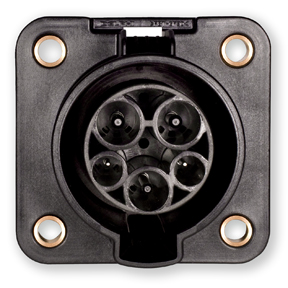Last Update: August 6, 2019

In the USA and other countries simple normal power outlets are available that support the power levels required for a decent recharging time. Shown here is a NEMA 14-50 outlet that supports up to 240 volts single phase AC and 40 amps continuous. That pencils out to a 9.6 kiloWatt charging rate, which is 1 1/2 times the 6 kW charge rate of typical electric cars.
In a conference back in 2009, early in my years of writing news articles about electric cars, I was faced with a panel of automaker engineers describing the J1772 charging plug. They said we'd be required to use this charging plug as the only means for charging electric cars. So I stood up and asked "WHY"? This seemed like a way to prevent us from recharging at any available power outlet, and therefore limit where and when we could recharge. I pointed out that NEMA 14-50 outlets are easily available, such as at RV parks.
Having studied the J1772 charging standard, I now understand why they decided to require a special purpose charging cord.

This is the charging inlet used in the USA and some other countries. In Europe and some other areas, a different plug is used, but the same J1772 protocol is used.
The charging connector has three pins to carry the power (2 "hot" lines, and a ground line) plus two additional pins for control signaling. These two extra pins are why we are required to use this connector, because of all the safety features provided by this connector. For all the reasons why charging cords are required, see: Why is a special charging cord (J1772) required to charge an electric car?
As for plugging into a regular power outlet, consider this charging station:

On one end is the charging connector, and on the other end is a regular regular power plug. In this case it is a NEMA 6-50 which has all the same characteristics as a 14-50. The box in the middle is where the safety features are implemented.
Some EVSE's are designed to be plugged into a regular power outlet.
This makes installation simple. You'd hire an electrician to install a suitable power outlet, then simply mount the charging station on a wall. See: How to plan for and install 240 volt circuit to charge an electric car/vehicle?
But what about taking a charging station on a trip to use in the field? You might rent a cabin in the woods for a week, and need charging while there. The HCS-40P shown here is a bit too large to use in this scenario. There are smaller charging stations available, for a complete list see: The best electric car charging stations for home charging or on trips


